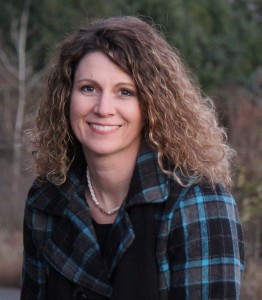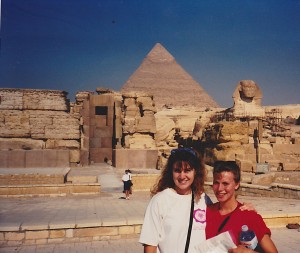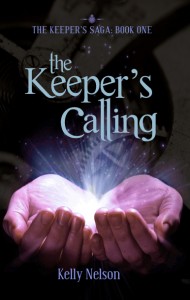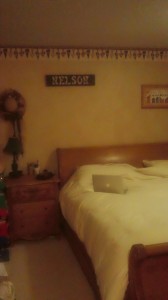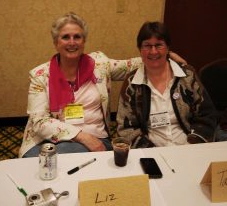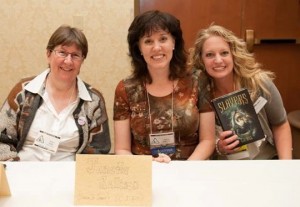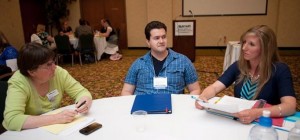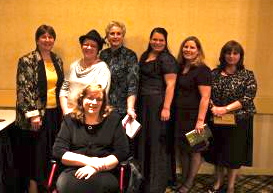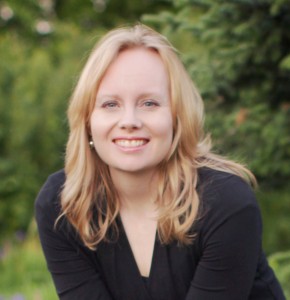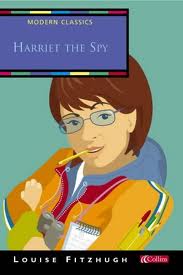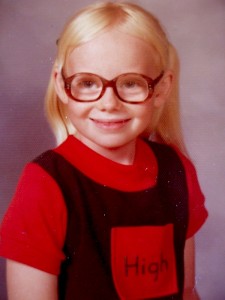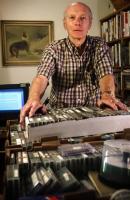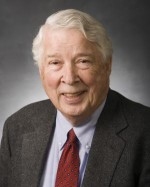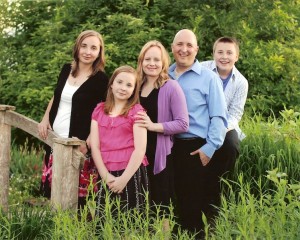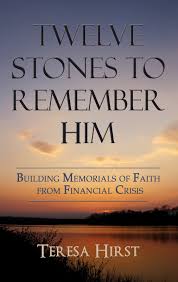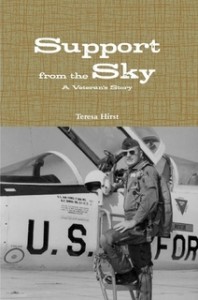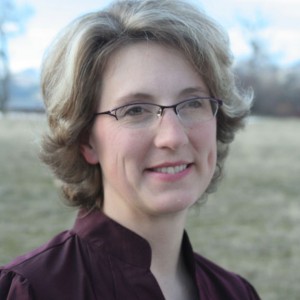I have yet to meet Kelly Nelson face to face, even though we share the same publisher, Walnut Springs, and she lives in my general neck of the woods–the Great Northwest. Still, I can’t wait for an opportunity to do a book signing together (hint, hint, Amy) because she certainly seems to have a way with in-person sales! While she’s only published one novel so far, I expect a lot more to follow because it’s the first in a series, The Keeper’s Saga! In fact, the sequel to THE KEEPER’S CALLING is due out in January. She lives on a large horse property with her husband and four children.
ME: How did you come to love horses and do they ever figure into your writing? (Also, I must have a picture of you riding.)
KELLY: I think I was born with the “horse gene.” There is an audiotape of my dad interviewing me when I was 3 years old and he says, “What do you love?” My answer: “Horses.” One of my first toys was a spring-style rocking horse purchased from a garage sale. I remember playing with that until I was at least 10 years old.
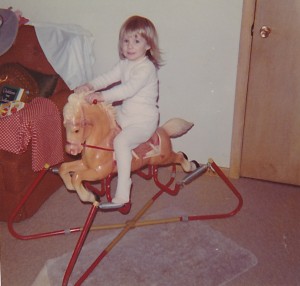 Wasn’t she a cutie? How many of us had one of these?
Wasn’t she a cutie? How many of us had one of these?
Every book I have ever written has horses in it. I figure life would be pretty boring without them, so my books must need to have them, as well.
ME: What was the most life-changing event of your childhood or adolescence, and could you describe how it affected you?
KELLY: Getting my first horse was definitely the most life-changing. Being desperate for a horse, I jumped at the chance to have any one I could get my hands on. The first horse my dad and I looked at was Misty, a thoroughbred off the racetrack. I think he liked the fact that she was fast, or maybe he was already tired of looking. (My vote’s the former.) Anyway, we bought her, and I had to learn to cowboy up or that horse would run right over me. Out of necessity, I overcame my natural shyness and developed self-confidence. (So that’s what I need to excel at Costco Signings? A fast horse? Hmm…not sure my back could take it.) The challenges I faced as a result of my horses have definitely shaped me into the person I am today.
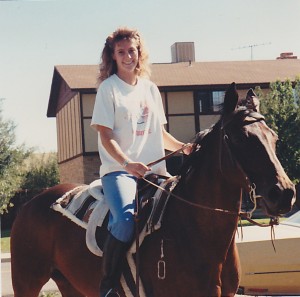 There’s my promised riding picture! Kelly on Misty.
There’s my promised riding picture! Kelly on Misty.
ME: How old were you when you wrote your first story that wasn’t an assignment? Do you still have it and can you summarize it for us? (A picture of you at that age would also be nice.)
KELLY: The first story I remember writing was called Cassandra. I wrote it when I was fifteen and a freshman in high school. It was the beginning of a novel about a princess caught in the crossfire of two kingdoms battling to settle a boundary dispute. And of course there is a knight in shining armor and a peasant boy she can’t help but fall in love with. I hadn’t plotted it out, so the story fizzled after about thirty pages. And yes, I still have those old sheets of notebook paper stuffed in some obscure box in my closet.
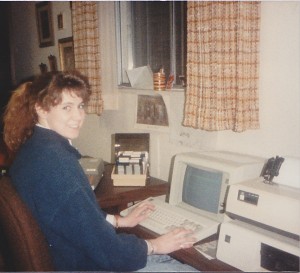 Check out that relic she’s typing on! Do you remember the green letters? But, hey, I’m impressed…she’s all set up and organized to be a writer at 15!
Check out that relic she’s typing on! Do you remember the green letters? But, hey, I’m impressed…she’s all set up and organized to be a writer at 15!
ME: Okay, I married an accountant. He’s a terrific organist, too, but hardly has a creative bone in his body (except for the lovely poems he wrote while courting me)…so how did you go from being “an avid reader” with “a passion for creative writing” to a numbers cruncher? And what made you return to your real love?
KELLY: My first passion has always been the horses. As a teenager, I recognized horses are an expensive hobby and I didn’t want the lack of money to prevent me from following my dreams. My dad was a CPA and professor of accounting at BYU, so it seemed natural to follow in his footsteps. Accounting concepts came easy for me and it was a field with a lot of job opportunities. Plus, it helped having a built-in tutor in the family.
It wasn’t until my youngest daughter went to school that I longed to pursue my writing dream. It started as a New Year’s resolution–see if I could actually write 80,000 words, have them make sense, and be a story someone would want to read. Three years later I was published, but let me tell you, they were long, hard years. (I think many of us can identify with that last bit. :D)
ME: What are some of the main differences between the residents of Orem, Utah, where you were raised, and Cornelius, Oregon, where you now live? And which community do you pull from more for characters in your fiction?
KELLY: Orem is a city environment and where I live now is very rural. When I was growing up, Orem had a high percentage of members of The Church of Jesus Christ of Latter-day Saints. Where I live now, there is a wider variety of people in terms of their faith and their values. I have now lived in Oregon longer than I lived in Utah, so I am more familiar with the Oregon setting and use that more often in my writing.
ME: How is it that you came to travel to such distant lands as England, France, Egypt, Israel, and the West Indies? (I’m guessing a Jerusalem Study Abroad took you to Egypt and Israel…but the West Indies?) Also, I’d love a picture of you in front of the Pyramids. You must have taken one, because everyone does.
KELLY: You are right about the study abroad thing (Yes!), but I actually did the London study abroad during college. (Oh…okay, only half right. I did London, too, by the way.) At the end of our time in Great Britain, we spent 5 days in France, and two weeks touring Egypt, Jordan, and Israel. It was our director’s last year coordinating the summer semester, London study abroad and his youngest daughter was one of the students, so I think he went all out to make it an unforgettable experience. (I’ll say!) One of the perks of my husband’s job is the occasional reward trip. Because of that, we have traveled to fancy resorts in the West Indies, Mexico, the Bahamas, and Hawaii. (Nice!)
ME: What gave you the idea for your first book, THE KEEPER’S CALLING, and what process did you follow to write it? Also, what are you working on now?
KELLY: I have always been fascinated with time travel and knew I wanted to incorporate that into my novel. The events comprising the first three chapters came to mind while on a hike in Zion National Part in southern Utah. I saw several indentations in the sandstone walls and thought to myself, “What if those were caves? What if you found something buried in there that took you back in time?”
I decided on a male, high school senior for my main character and then thought, “Oh, what if he met a girl back there?” And the rest is history, or rather The Keeper’s Saga. (Hmm…I think I’ll bump this up on my reading list.)
I am currently editing the third book in my Keeper’s Saga trilogy and contemplating a companion book that tells Garrick the Guardian’s story.
ME: We’ve got to get a look at your writing space. Please provide a picture and tell us what knick-knack on your desk means the most to you and why.
KELLY: You’ll laugh for sure. I don’t have a desk. (What? What happened to that super-organized 15-year-old?) Sitting at one tends to make my legs and back ache. I do have an incredible oak sleigh bed with a perfectly curved headboard. One laptop, a few pillows stacked behind me, and my memory foam mattress have provided all I really needed in the way of creative space.
I frequently tote my laptop around to my kids’ sporting activities, piano lessons, swim lessons, etc. I am willing to write anytime, any place. I was addicted to it when I was writing The Keeper’s Saga. It was like reading a good book–I couldn’t put it down.
ME: Finally, it has long been apparent to me that you are the “Costco Queen.” What are your secrets to a successful Costco Signing (beyond the self-confidence built up by Misty), and what was the strangest encounter you’ve had yet?
KELLY: First of all, strangest encounter: The man and his friend who were buying a huge cart full of beer, Gatorade, chips, and other snacks for the weekend Cycle Oregon event. He had me sign a book for his 16-year-old daughter, then wanted a picture of me with him. When I stood up for the picture, he ran his eyes down me and said, “You’re a tall drink of water.” (I am 5’9″ and I was wearing heels.) I had no idea what to say to that. As if I wasn’t there, he started saying to his friend, “We should take her with us. Wouldn’t it be fun if she came with us?” This guy talked non-stop and it was hard to get a word in edgewise. Luckily, I was able to hurry them on their way and I never heard from him again. (Okay, regardless of the sleazy come-on, do you see now why I want to do a signing with Kelly? She’s hard to resist, so even if you don’t sell a lot, you’re sure to have a fun time watching her shoot down all these men…with grace, of course.)
Hmm, Costco sales strategy: I don’t know that I have any special secrets, but I dress professionally and wear my lucky lipstick, :D …plus, I feel like the premise to my book is appealing to a wide variety of readers. If you’re interested, here is the long version of what has worked for me.
First of all, I’ve noticed there are a lot of people who don’t realize what I am doing there. You would think it is pretty obvious, but I have had so many people ask me for clarification. Even after introducing myself as either a “local author signing books today” or in Utah, I say, “I’m from Oregon and I’m in town signing books today,” they will still ask, “You wrote this book?” or “Will you sign it for me if I buy it?” I figured this out on my second book signing in Oregon. A lot of people assume we are Costco employees, so I think it is important to make sure they know who I am and why I’m there.
To get people to pause long enough for me to tell them this, I say, “Would you like a bookmark?” The negative of this is that you can burn through a lot of bookmarks. (If you buy in bulk, like 4,000, they are around $.02 each.) I used to hold the bookmark out to them as I asked, but then I realized that I was making it easier for them to take it than to say no, and I was probably giving bookmarks to people to whom I had no chance of selling a book. Now I ask people without actually holding the bookmark out. If they are interested, they have to walk over, but if not, it is easier for them to turn me down than to take the bookmark.
You can kind of tell when someone is interested by the longing look in their eyes or their body language. Sometimes I hold out the book and say, “You can take a look at it, if you’d like.” I’m always surprised at how many people will take it and say, “Thank you,” like I just did something really nice for them. Getting the book in their hands is always a step in the right direction. If they linger after I introduce myself and look a little interested, I will just keep talking. I flip the book over and point to the counter on the back and say, “It’s about a high school senior who finds this gold device buried in a cave on a summer camping trip in Zion’s. He touches one of the buttons inside and it takes him back to 1863. Of course, he has NO idea what has happened to him. He rescues a girl back there and saves her life. It was her grandfather who buried the counter, so as long as he’s alive it will only work for him. And of course there are people who want to take it.” Give or take a little, that is basically what I say.
I try to find something about my book that might appeal to people wherever I am, and I try to find something that makes me unique. So at home, I say I’m local. In Utah, I say I’m from Oregon. In Oregon, I say the book is set locally, or it is about a Hilhi senior. In Utah, I make sure to include the bit about Zion National Park.
When they ask me what age group it is for, I tell them young adult fiction. But I’ve noticed if I can tell some specific stories about actual readers, that usually gives me a good response from potential buyers. For example, I might say, “I’ve had kids as young as 10 and 11 read it, all the way up to a 90-year-old man who read it twice because he liked it so well.”
That was an info dump if I ever saw one. :D Probably way more information than you wanted.
Not at all. I’m sure there are plenty of writers (including me) who will appreciate the tips. And if any of you want to know more about Kelly and The Keeper’s Saga, just click on her website. Ready to start reading her series? Click here.
Originally posted 2012-12-05 13:03:05.

